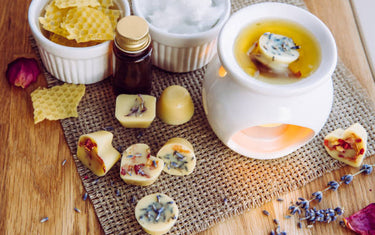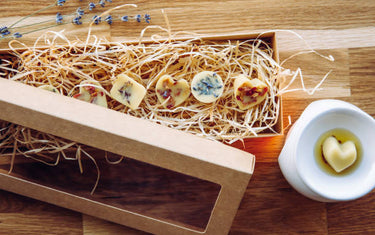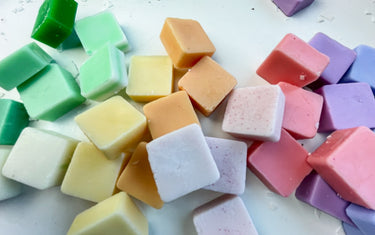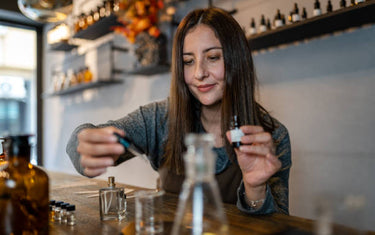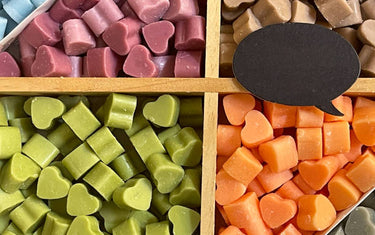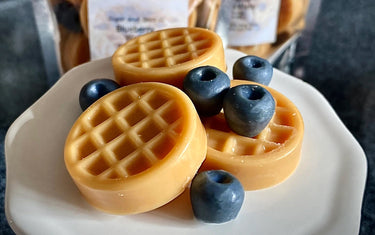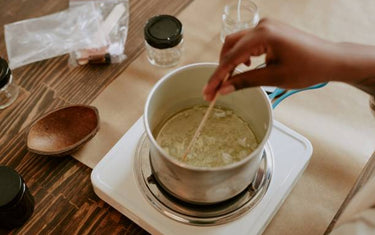7 min read / 24 February 2025 / yasmin sharp
5. Crafting Perfect Wax Melt Fragrances
Learn how to formulate wax melts with the perfect fragrance load, blend accords and bases for unique scents, and test for optimal fragrance strength and longevity.
Share this post
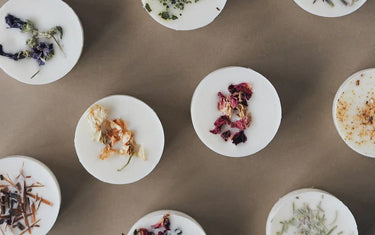
A Complete Guide to Formulating Perfect Scents and Scent Throw
Learning how to make wax melts doesn't have to be difficult. In fact, it can be pretty fun.
In this blog, we'll teach you how to formulate wax melts with the perfect fragrance load, blend accords, and bases to create unique scents.
We’ll also take a look at how you can test fragrance strength and longevity. Whether you are a beginner or experienced in DIY wax melts, our guide will help you achieve the best results.

Fragrance Load and Scent Throw
What is Fragrance Load?
Fragrance load refers to the amount of fragrance oil or essential oil you add to your wax melts, measured as a percentage of the total weight of the wax. It determines how much scent your wax melt will emit.
Too much fragrance oil can affect the texture and burn quality of wax, while too little can lead to a weak scent throw.
How to Calculate the Right Fragrance Load
A typical fragrance load for wax melts is 6-10%. So, how do you calculate it? All you need to do to work out the right amount of fragrance oil is use the following formula:
Fragrance Load Formula:
Fragrance Oil Weight = (Fragrance Load Percentage ÷ 100) × Total Wax Weight
For example, if you’re using 500g of wax and want an 8% fragrance load:
- Fragrance Oil Weight = (8 ÷ 100) × 500g = 40g
This means you will need 40g of fragrance oil for 500g of wax.
Understanding Scent Throw
Scent throw is the distance a fragrance travels in a room. However, there are two main types of scent throw that you need to know:
- Cold Scent Throw: The fragrance you smell when the wax melt is solid.
- Hot Scent Throw: The fragrance released when the wax melt is warmed (so when it's lit).
To make the scent throw for your wax melts as good as it can be, you should make sure your fragrance oil is mixed properly with the wax at the right temperature.
The ideal pouring temperature is typically between 60-70°C, depending on the type of wax you're using.
- Soy Wax: 55-65°C (optimal for retaining fragrance and reducing frosting)
- Paraffin Wax: 60-70°C (best for good adhesion and scent throw)
- Beeswax: 70-75°C (higher temperature helps prevent cracking as it cools)
- Coconut Wax: 60-70°C (blends well with fragrance oils at this range)
- Gel Wax: 80-95°C (higher temperature helps ensure clarity and proper blending)
- Palm Wax: 80-90°C (higher pour temperatures ensure better crystallisation patterns)
These temperatures ensure proper bonding with fragrance oils and means you’re less likely to come across issues such as frosting, cracking, or weak scent throw.
Improving Scent Throw with Additives
Certain additives, like Vybar or Stearic Acid, can improve scent throw and help the wax hold more fragrance oil.
They can also stabilise the wax and make it more resistant to blooming or frosting (a common issue with soy wax).
They're a good choice if you want to improve the overall performance and appearance of your wax melts without compromising the scent profile.
Common Mistakes to Avoid
If you want to make a good batch of wax melts, you should try to avoid these common mistakes:
- Overloading Fragrance Oil: This can cause the wax melt to become soft, reducing burn quality and potentially leaking fragrance oil.
- Underloading Fragrance Oil: This can lead to a weak scent throw, wasting both the wax and fragrance oil.
- Wrong Pouring Temperature: Pouring wax at too high or too low a temperature can affect the fragrance bonding, leading to poor scent throw.

Blending Accords and Bases
What Are Fragrance Accords and Bases?
Fragrance accords are combinations of different fragrance notes that work well together.
A base is the foundation of a scent. In perfumery, fragrances are structured in layers:
- Top Notes: The initial, lighter scents (e.g. citrus, herbs).
- Middle Notes: The core of the scent (e.g. florals, spices).
- Base Notes: The deep, long-lasting scents (e.g. woods, musk).
Creating Harmonious Blends
Making your own scent profile can be one of the most enjoyable parts when you're learning how to make wax melts. However, to create a balanced scent profile, you'll want to blend different accords together. Here's how:
- Choose a top note for freshness (e.g. bergamot, lavender).
- Add a middle note for body (e.g. rose, jasmine).
- Anchor the scent with a base note for depth (e.g. vanilla, sandalwood).
Example Blends
Here are a few examples of popular fragrance blends you can try for your wax melts:
- Floral Accord: Jasmine (middle), bergamot (top), sandalwood (base).
- Fruity Accord: Pear (middle), lemon (top), amber (base).
- Gourmand Accord: Vanilla (middle), caramel (top), patchouli (base).
Experimentation
Don’t be afraid to experiment with different accords. You can create unique scent profiles by blending unusual combinations, like mixing florals with spices or fruits with wood.
The key to crafting custom fragrances is testing and refining your blends until you achieve the desired result. If you're unsure where to start, we have a few ideas you can try.
Fragrance Families to Explore
Consider working with fragrance families when experimenting:
- Citrus: Energising and fresh (e.g. lemon, grapefruit).
- Woody: Earthy and grounding (e.g. cedarwood, sandalwood).
- Oriental: Warm and spicy (e.g. amber, cinnamon).
- Aquatic: Crisp and clean (e.g. ocean breeze, fresh air).

Creating Unique Scents
Finding Inspiration
- Nature: Fresh flowers, earthy woods, or seaside breezes.
- Personal Memories: Favourite holiday scents, food, or nostalgic moments.
- Trends: Seasonal fragrances or trending ingredients (e.g. coconut in summer, cinnamon in winter).
Customising Scent Profiles
You can customise a scent to cater to personal preferences or market demands by adjusting the fragrance balance. For example, adding more base notes can make the scent more long-lasting, while boosting the top notes can make it more vibrant.
Essential Oils vs Synthetic Fragrance Oils
When creating wax melts, you have two primary options for fragrance oils: natural essential oils or synthetic fragrance oils.
- Essential Oils: Natural, plant-based oils that offer a more organic scent but may have a weaker scent throw and shorter longevity.
- Synthetic Fragrance Oils: Man-made oils that provide stronger, longer-lasting scents and more versatility in your scent profiles.
Combining Essential and Synthetic Oils
Many people who make wax melts choose to mix essential oils with synthetic fragrance oils to create a unique scent profile.
For instance, blending natural lavender essential oil with a synthetic vanilla fragrance oil can offer the best of both worlds: a natural base with a stronger scent throw and a longer-lasting fragrance.
How to Make Wax Melts with Essential Oils
How to make wax melts with essential oils is a slightly different process from using synthetic fragrance oils. Essential oils are more volatile and sensitive to heat, so it’s important to pour the wax at a lower temperature (around 55°C) to preserve their potency.
Likewise, as they have more of a natural origin, you might need to use a higher fragrance load to achieve the scent you want.
Avoiding Common Blending Errors
Some mistakes in blending fragrances include:
- Clashing Notes: Avoid blending scents that are too contrasting (e.g. heavy musk with light citrus).
- Overcomplicating Blends: Stick to no more than three main notes to avoid muddling the scent.
- Imbalanced Fragrances: Make sure your top, middle, and base notes are balanced for a well-rounded scent.
Fragrance Oils and Essential Oils for Wax Melts
If you’re unsure where to start when it comes to selecting fragrance oils and essential oils for wax melts, here are some popular suggestions:
- Lavender: A soothing, floral scent.
- Vanilla: A warm, cosy, sweet fragrance.
- Citrus Blend (Lemon, Orange, Grapefruit): Fresh and energising.
- Sandalwood: Earthy and woody.
- Peppermint: Cool, crisp, and refreshing.
- Cinnamon and Clove: Perfect for autumn and winter, providing a spicy and warming effect.
- Jasmine: A delicate, romantic floral.
- Bergamot: Uplifting and citrusy.
- Coconut: Tropical and refreshing.

Testing Fragrance Strength and Longevity
The Importance of Testing
Testing is one of the final steps when creating wax melts. It's always a good idea to test, as every wax and fragrance oil combination will behave differently.
It will also help you see whether you have the correct scent throw, fragrance load, and longevity. If not, then it's time to go back and tweak your wax melt recipe.
Methods of Testing
There are several ways to test the strength and longevity of your wax melts:
- Cold Sniff Test: Once your wax melt has cooled, smell the solid melt to check the cold scent throw.
- Burn Test: Melt the wax in a warmer and evaluate the scent throw and longevity over time.
- Room Size Test: Test how well the scent fills different-sized rooms to ensure it has adequate throw for your intended space.
Time-Testing for Longevity
To properly test fragrance longevity, conduct a burn test over several hours. Track how the scent strength changes over time, checking at regular intervals (e.g. after 2, 4, and 6 hours). This will help you determine if the scent has the lasting power you’re aiming for.
Adjusting Formulations
Based on your testing results, you can adjust your fragrance load and blend:
- If the scent is too weak, increase the fragrance load by 1-2%.
- If the scent is too strong, reduce the fragrance load slightly to avoid overpowering the room.
- Adjust the balance of accords if certain notes are too dominant or too subtle.
Documenting Results
Keep detailed notes on each test, including:
- Wax type and weight
- Fragrance oils used
- Fragrance load percentage
- Pouring temperature
- Testing results (strength, throw, longevity)
This will help you refine your process and ensure consistency in your final product.
How Long Do Wax Melts Last?
So, how long do wax melts last? Wax melts can typically last between 8 to 12 hours of active melting, but it depends on fragrance load and the quality of the fragrance oil used. The longevity also depends on the type of wax and the fragrance oil’s strength.

In Summary
Now that you know how to make wax melts, it’s time to start experimenting with your own custom fragrances. Whether blending accords, testing fragrance oils for wax melts, or adjusting your fragrance strengths, get practising and get creative.
If you need wax melt supplies such as essential or fragrance oils at a discount, then sign up for a Nikura wholesale account. You’ll get access to exclusive deals and discounts.

